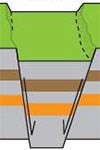
Divergent Plate Boundaries
Almost all the Earth’s new crust forms at divergent boundaries, but most are not well known because they lie deep beneath the oceans. These are zones where two plates move away from each other, allowing magma from the mantle to rise up and solidify as new crust. When divergent motion occurs beneath a continental plate, rift structures and normal faults form.
Continental Rifts—Active
- CIRO—City of Rocks National Reserve, Idaho—[Geodiversity Atlas] [Park Home]
- CRMO—Craters of the Moon National Monument, Idaho—[Geodiversity Atlas] [Park Home]
- DEVA—Death Valley National Park, California & Nevada—[Geodiversity Atlas] [Park Home]
- DEPO—Devils Postpile National Monument, California—[Geodiversity Atlas] [Park Home]
- GOSO—Golden Spike National Historic Site, Utah—[Geodiversity Atlas] [Park Home]
- GRCA—Grand Canyon National Park, Arizona—[Geodiversity Atlas] [Park Home]
- GRTE—Grand Teton National Park, Wyoming—[Geodiversity Atlas] [Park Home]
- GRBA—Great Basin National Park, Nevada—[Geodiversity Atlas] [Park Home]\
- JOTR—Joshua Tree National Park, California—[Geodiversity Atlas] [Park Home]
- LAKE—Lake Mead National Recreation Area, Arizona & Nevada—[Geodiversity Atlas] [Park Home]
- LABE—Lava Beds National Monument, California—[Geodiversity Atlas] [Park Home]
- MOJA—Mojave National Preserve, California—[Geodiversity Atlas] [Park Home]
- ORPI—Organ Pipe Cactus National Monument, Arizona—[Geodiversity Atlas] [Park Home]
- SAGU—Saguaro National Park, Arizona—[Geodiversity Atlas] [Park Home]
- SUCR—Sunset Crater National Monument, Arizona—[Geodiversity Atlas] [Park Home]
- TICA—Timpanogos Cave National Monument, Utah—[Geodiversity Atlas] [Park Home]
- BAND—Bandelier National Monument, New Mexico—[Geodiversity Atlas] [Park Home]
- CAVO—Capulin Volcano National Monument, New Mexico—[Geodiversity Atlas] [Park Home]
- CAVE—Carlsbad Caverns National Park, New Mexico—[Geodiversity Atlas] [Park Home]
- GUMO—Guadalupe Mountains National Park, Texas—[Geodiversity Atlas] [Park Home]
- PETR—Petroglyph National Monument, New Mexico—[Geodiversity Atlas] [Park Home]
- VALL—Valles Caldera National Preserve, New Mexico—[Geodiversity Atlas] [Park Home]
- WHSA—White Sands National Monument, New Mexico—[Geodiversity Atlas] [Park Home]
Continental Rifts—Ancient
- APIS—Apostle Islands National Lakeshore, Wisconsin—[Geodiversity Atlas] [Park Home]
- GRPO—Grand Portage National Monument, Minnesota—[Geodiversity Atlas] [Park Home]
- ISRO—Isle Royale National Park, Michigan—[Geodiversity Atlas] [Park Home]
- KEWE—Keweenaw National Historical Park, Michigan [Geodiversity Atlas] [Park Home]
- PIRO—Pictured Rocks National Lakeshore, Michigan—[Geodiversity Atlas] [Park Home]
- SACR—Saint Croix National Scenic Riverway, Minnesota & Wisconsin—[Geodiversity Atlas] [Park Home]
Passive Continental Margins—Modern
- ASIS—Assateague Island National Seashore, Maryland & Virginia—[Geodiversity Atlas] [Park Home]
- BISC—Biscayne National Park, Florida—[Geodiversity Atlas] [Park Home]
- CANA—Canaveral National Seashore, Florida—[Geodiversity Atlas] [Park Home]
- CACO—Cape Cod National Seashore, Massachusetts—[Geodiversity Atlas] [Park Home]
- CAHA—Cape Hatteras National Seashore, North Carolina—[Geodiversity Atlas] [Park Home]
- CALO—Cape Lookout National Seashore, North Carolina—[Geodiversity Atlas] [Park Home]
- CUIS—Cumberland Island National Seashore, Georgia—[Geodiversity Atlas] [Park Home]
- FIIS—Fire Island National Seashore, New York—[Geodiversity Atlas] [Park Home]
- DRTO—Dry Tortugas National Park, Florida—[Geodiversity Atlas] [Park Home]
- EVER—Everglades National Park, Florida—[Geodiversity Atlas] [Park Home]
- GUIS—Gulf Islands National Seashore, Florida & Mississippi—[Geodiversity Atlas] [Park Home]
- PAIS—Padre Island National Seashore, Texas—[Geodiversity Atlas] [Park Home]
Passive Continental Margins—Ancient
- CANY—Canyonlands National Park, Utah—[Geodiversity Atlas] [Park Home]
- CEBR—Cedar Breaks National Monument, Utah—[Geodiversity Atlas] [Park Home]
- GRCA—Grand Canyon National Park, Arizona—[Geodiversity Atlas] [Park Home]
- PEFO—Petrified Forest National Park, Arizona—[Geodiversity Atlas] [Park Home]
- WACA—Walnut Canyon National Monument, Arizona—[Geodiversity Atlas] [Park Home]
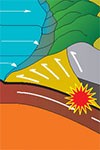
Convergent Plate Boundaries
The way that plates behave when they collide depends mostly on what type of lithosphere they are made of. In oceanic-contentental subduction, the oceanic plate is pulled beneath another, forming a deep trench. The long, narrow zone where the two plates meet is called a subduction zone. In continental-continental plate collision, the crusts are pushed together and faulted forming towering mountain ranges.
Subduction Zones—Active
- OLYM—Olympic National Park, Washington [Geodiversity Atlas] [Park Home]
- ORCA—Oregon Caves National Monument, Oregon [Geodiversity Atlas] [Park Home]
- REDW—Redwood National Park, California [Geodiversity Atlas] [Park Home]
-
KEFJ—Kenai Fjords National Park, Alaska—[Geodiversity Atlas] [Park Home]
-
CRLA—Crater Lake National Park, Oregon—[Geodiversity Atlas] [Park Home]
-
LAVO—Lassen Volcanic National Park, California—[Geodiversity Atlas] [Park Home]
-
MORA—Mount Rainier National Park, Washington—[Geodiversity Atlas] [Park Home]
-
ANIA—Aniakchak National Monument and Preserve, Alaska—[Geodiversity Atlas] [Park Home]
-
KATM—Katmai National Park, Alaska—[Geodiversity Atlas] [Park Home]
-
LACL—Lake Clark National Park, Alaska—[Geodiversity Atlas] [Park Home]
Accreted Terranes
- DENA—Denali National Park, Alaska—[Geodiversity Atlas] [Park Home]
- GLBA—Glacier Bay National Park and Preserve, Alaska—[Geodiversity Atlas] [Park Home]
- WRST—Wrangell - St. Elias National Park and Preserve, Alaska—[Geodiversity Atlas] [Park Home]
- LACH—Lake Chelan National Recreation Area, Washington (see North Cascades)—[Geodiversity Atlas] [Park Home]
- NOCA—North Cascades National Park, Washington—[Geodiversity Atlas] [Park Home]
- ROLA—Ross Lake National Recreation Area, Washington—[Geodiversity Atlas] [Park Home]
Subduction Zones—Ancient
- SEKI—Kings Canyon National Park, California—[Geodiversity Atlas] [Park Home]
- SEKI—Sequoia National Park, California—[Geodiversity Atlas] [Park Home]
- YOSE—Yosemite National Park, California—[Geodiversity Atlas] [Park Home]
Collisional Mountain Ranges—Appalachain-Ouachita-Marathon
-
ACAD—Acadia National Park, Maine—[Geodiversity Atlas] [Park Home]
-
BISO—Big South Fork National River and Recreation Area, North Carolina & Tennessee—[Geodiversity Atlas] [Park Home]
-
BLRI—Blue Ridge Parkway, Virginia & North Carolina—[Geodiversity Atlas] [Park Home]
- BLUE—Bluestone National Scenic River, West Virginia—[Geodiversity Atlas] [Park Home]
- CHAT—Chattahoochee River National Recreation Area, Georgia—[Geodiversity Atlas] [Park Home]
- DEWA—Delaware Water Gap National Recreation Area, Pennsylvania—[Geodiversity Atlas] [Park Home]
-
GARI—Gauley River National Recreation Area, West Virginia—[Geodiversity Atlas] [Park Home]
- GRSM—Great Smoky Mountains National Park, North Carolina & Tennessee—[Geodiversity Atlas] [Park Home]
- NERI—New River Gorge National River, West Virginia—[Geodiversity Atlas] [Park Home]
-
OBED—Obed Wild and Scenic River, Tennessee—[Geodiversity Atlas] [Park Home]
-
RUCA—Russell Cave National Monument, Alabama—[Geodiversity Atlas] [Park Home]
-
SHEN—Shenandoah National Park, Virginia—[Geodiversity Atlas] [Park Home]
-
HOSP—Hot Springs National Park, Arkansas—[Geodiversity Atlas] [Park Home]
- BIBE—Big Bend National Park, Texas—[Geodiversity Atlas] [Park Home]
- RIGR—Rio Grand Wild and Scenic River, Texas—[Geodiversity Atlas] [Park Home]
Collisional Mountain Ranges—Northern Alaska
- CAKR—Cape Krusenstern National Monument, Alaska—[Geodiversity Atlas] [Park Home]
- GAAR—Gates of the Arctic National Park and Preserve, Alaska—[Geodiversity Atlas] [Park Home]
-
KOVA—Kobuk Valley National Park, Alaska—[Geodiversity Atlas] [Park Home]
- NOAT—Noatak National Preserve, Alaska—[Geodiversity Atlas] [Park Home]
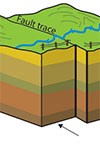
Transform Plate Boundaries
At transform plate boundaries plates grind past each other side by side. This type of boundary separates the North American plate from the Pacific plate along the San Andreas fault, a famous transform plate boundary that’s responsible for many of California’s earthquakes.
Continental
- CHIS—Channel Islands National Park, California [Geodiversity Atlas] [Park Home]
- CABR—Cabrillo National Monument, California—[Geodiversity Atlas] [Park Home]
- GOGA—Golden Gate National Recreation Area, California—[Geodiversity Atlas] [Park Home]
- PINN—Pinnacles National Monument, California—[Geodiversity Atlas] [Park Home]
- PORE—Point Reyes National Seashore, California—[Geodiversity Atlas] [Park Home]
- SAMO—Santa Monica Mountains National Recreation Area, California—[Geodiversity Atlas] [Park Home]
Oceanic
- BUIS—Buck Island Reef National Monument, U.S. Virgin Islands—[Geodiversity Atlas] [Park Home]
- VIIS—Virgin Islands National Park, U.S. Virgin Islands—[Geodiversity Atlas] [Park Home]
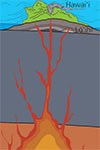
Hotspots
A hotspot is area of concentrated heat in the mantle that produces magma that rises to the Earth’s surface to form volcanic features. The volcanic activity of the Hawaiian Islands is one example. Hotspots may persist for millions of years.
Continental Hotspot
- CRMO—Craters of the Moon National Monument, Idaho—[Geodiversity Atlas] [Park Home]
- HAFE—Hagerman Fossil Beds National Monument, Idaho—[Geodiversity Atlas] [Park Home]
- JODA—John Day Fossil Beds National Monument, Oregon—[Geodiversity Atlas] [Park Home]
- YELL—Yellowstone National Park, Wyoming, Idaho & Montana—[Geodiversity Atlas] [Park Home]
Oceanic Hotspot
- NPSA—National Park of the American Samoa, American Samoa—[Geodiversity Atlas] [Park Home]
- HALE—Haleakala National Park, Hawaii—[Geodiversity Atlas] [Park Home]
- HAVO—Hawaii Volcanoes National Park, Hawaii—[Geodiversity Atlas] [Park Home]
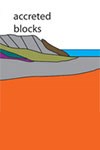
Growth of the North American Continent
A craton is the relatively stable nucleus of a continent. Cratons are made up of a shield-like core of Precambrian Rock and a buried extension of the shield. Accreted terrains are portions of crust that are too thick and buoyant to be subducted which are "scraped off" and become added to the over-riding tectonic plate along a convergent (collisional) plate boundary.
Continental Craton
- VOYA—Voyageurs National Park, Minnesota—[Geodiversity Atlas] [Park Home]
- AGFO—Agate Fossil Beds National Monument, Nebraska—[Geodiversity Atlas] [Park Home]
- ALFL—Alibates Flint Quarries National Monument, Texas—[Geodiversity Atlas] [Park Home]
- BADL—Badlands National Park, South Dakota—[Geodiversity Atlas] [Park Home]
- CUVA—Cuyahoga Valley National Park, Ohio—[Geodiversity Atlas] [Park Home]
- EFMO—Effigy Mounds National Monument, Iowa—[Geodiversity Atlas] [Park Home]
- INDU—Indiana Dunes National Park, Indiana—[Geodiversity Atlas] [Park Home]
- LAMR—Lake Meredith National Recreation Area, Texas—[Geodiversity Atlas] [Park Home]
- MACA—Mammoth Cave National Park, Kentucky—[Geodiversity Atlas] [Park Home]
- MISS—Mississippi National River and Recreation Area, Minnesota—[Geodiversity Atlas] [Park Home]
- MNRR—Missouri National Recreational River, South Dakota—[Geodiversity Atlas] [Park Home]
- NATR—Natchez Trace Parkway (AL, MS, and TN)—[Geodiversity Atlas] [Park Home]
- NIOB—Niobrara National Scenic River, Nebraska—[Geodiversity Atlas] [Park Home]
- OZAR—Ozark National Scenic Riverways, Missouri—[Geodiversity Atlas] [Park Home]
- PIPE—Pipestone National Monument, Minnesota—[Geodiversity Atlas] [Park Home]
- SCBL—Scotts Bluff National Monument, Nebraska—[Geodiversity Atlas] [Park Home]
- SLBE—Sleeping Bear Dunes National Lakeshore, Michigan—[Geodiversity Atlas] [Park Home]
- TAPR—Tallgrass Prairie National Preserve, Kansas—[Geodiversity Atlas] [Park Home]
- THRO—Theodore Roosevelt National Park, North Dakota—[Geodiversity Atlas] [Park Home]
Deformed Continental Craton
- ARCH—Arches National Park, Utah—[Geodiversity Atlas] [Park Home]
- BLCA—Black Canyon of the Gunnison National Park ,Colorado—[Geodiversity Atlas] [Park Home]
- BRCA—Bryce Canyon National Park, Utah—[Geodiversity Atlas] [Park Home]
- CACH—Canyon de Chelly National Monument, Arizona—[Geodiversity Atlas] [Park Home]
- CARE—Capitol Reef National Park, Utah—[Geodiversity Atlas] [Park Home] [Park fossil highlights]
- COLM—Colorado National Monument, Colorado—[Geodiversity Atlas] [Park Home]
- CURE—Curecanti National Recreation Area, Colorado—[Geodiversity Atlas] [Park Home]
- DINO—Dinosaur National Monument* (CO and UT)—[Geodiversity Atlas] [Park Home]
- ELMA—El Malpais National Monument, New Mexico—[Geodiversity Atlas] [Park Home]
- ELMO—El Morro National Monument, New Mexico—[Geodiversity Atlas] [Park Home]
- GLCA—Glen Canyon National Recreation Area (AZ and UT)—[Geodiversity Atlas] [Park Home]
- MEVE—Mesa Verde National Park, Colorado—[Geodiversity Atlas] [Park Home]
- NABR—Natural Bridges National Monument, Utah—[Geodiversity Atlas] [Park Home]
- NAVA—Navajo National Monument, Arizona—[Geodiversity Atlas] [Park Home]
- PISP—Pipe Spring National Monument, Arizona—[Geodiversity Atlas] [Park Home]
- RABR—Rainbow Bridge National Monument, Utah—[Geodiversity Atlas] [Park Home]
- TUZI—Tuzigoot National Monument, Arizona—[Geodiversity Atlas] [Park Home]
- WUPA—Wupatki National Monument, Arizona—[Geodiversity Atlas] [Park Home]
- ZION—Zion National Park, Utah—[Geodiversity Atlas] [Park Home]
- BICA—Bighorn Canyon National Recreation Area, Montana & Wyoming—[Geodiversity Atlas] [Park Home]
- DETO—Devils Tower National Monument, Wyoming—[Geodiversity Atlas] [Park Home]
- FLFO—Florissant Fossil Beds National Monument, Colorado—[Geodiversity Atlas] [Park Home]
- GRSA—Great Sand Dunes National Monument, Colorado—[Geodiversity Atlas] [Park Home]
- JECA—Jewel Cave National Monument, South Dakota—[Geodiversity Atlas] [Park Home]
- MORU—Mount Rushmore National Monument, South Dakota—[Geodiversity Atlas] [Park Home]
- ROMO—Rocky Mountain National Park, Colorado—[Geodiversity Atlas] [Park Home]
- WICA—Wind Cave National Park, South Dakota—[Geodiversity Atlas] [Park Home]
- Glacier National Park, Montana—[Geodiversity Atlas] [Park Home]
- YUCH—Yukon-Charley Rivers National Preserve, Alaska—[Geodiversity Atlas] [Park Home]
Accreted Terrains
- DENA—Denali National Park, Alaska—[Geodiversity Atlas] [Park Home]
- GLBA—Glacier Bay National Park and Preserve, Alaska—[Geodiversity Atlas] [Park Home]
- WRST—Wrangell - St. Elias National Park and Preserve, Alaska—[Geodiversity Atlas] [Park Home]
- LACH—Lake Chelan National Recreation Area, Washington (see North Cascades)—[Geodiversity Atlas] [Park Home]
- NOCA—North Cascades National Park, Washington—[Geodiversity Atlas] [Park Home]
- ROLA—Ross Lake National Recreation Area, Washington—[Geodiversity Atlas] [Park Home]
Related Links
Site Index & Credits
Plate Tectonics and Our National Parks
- Plate Tectonics—The Unifying Theory of Geology
- Inner Earth Model
- Evidence of Plate Motions
- Types of Plate Boundaries
- Tectonic Settings of NPS Sites—Master List
Teaching Resources—Plate Tectonics
Photos and Multimedia—Plate Tectonics
Geological Monitoring—Plate Tectonics
Plate Tectonics and Our National Parks (2020)
-
Text and Illustrations by Robert J. Lillie, Emeritus Professor of Geosciences, Oregon State University [E-mail]
-
Produced under a Cooperative Agreement for earth science education between the National Park Service's Geologic Resources Division and the American Geosciences Institute.
Last updated: December 5, 2022
